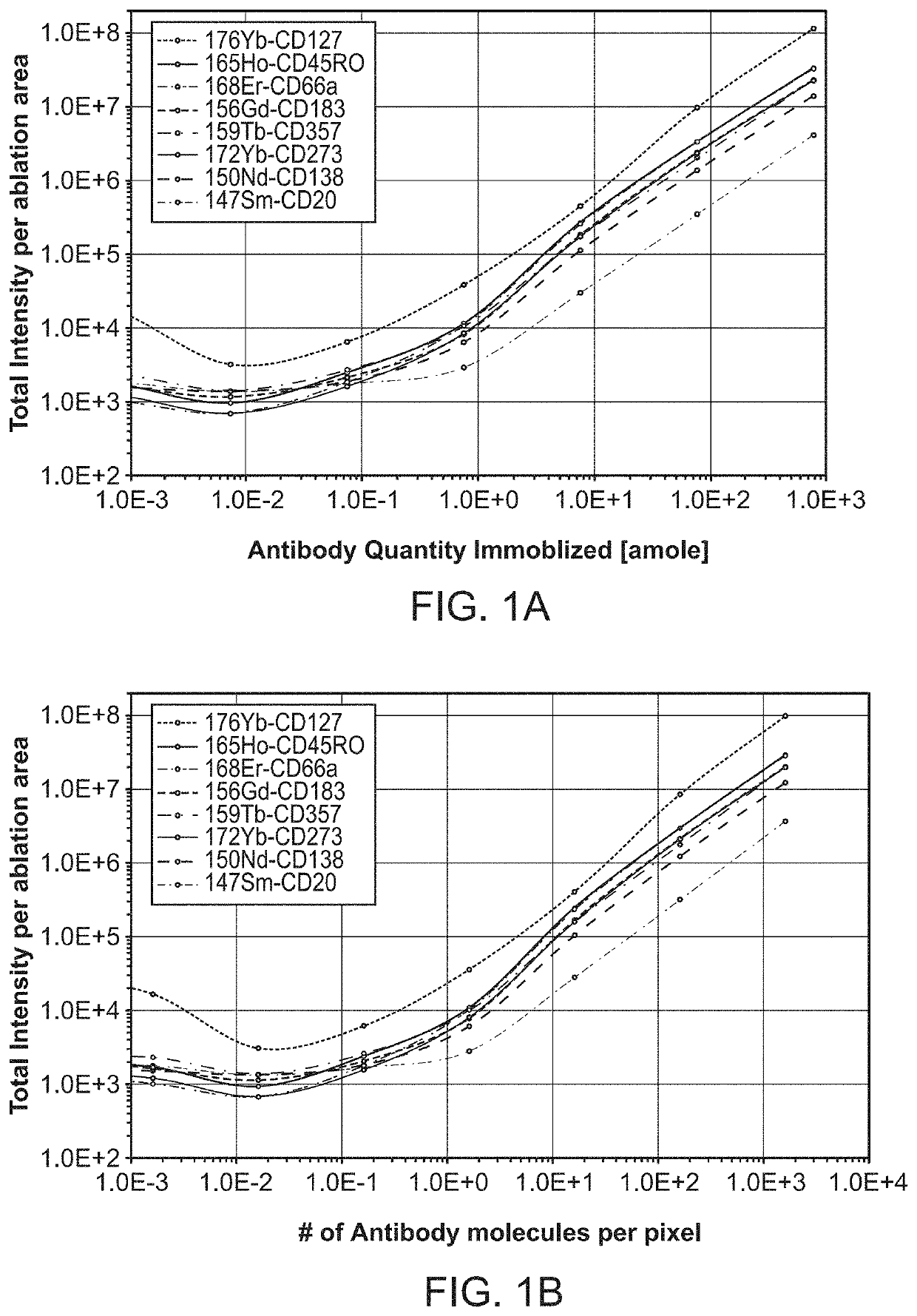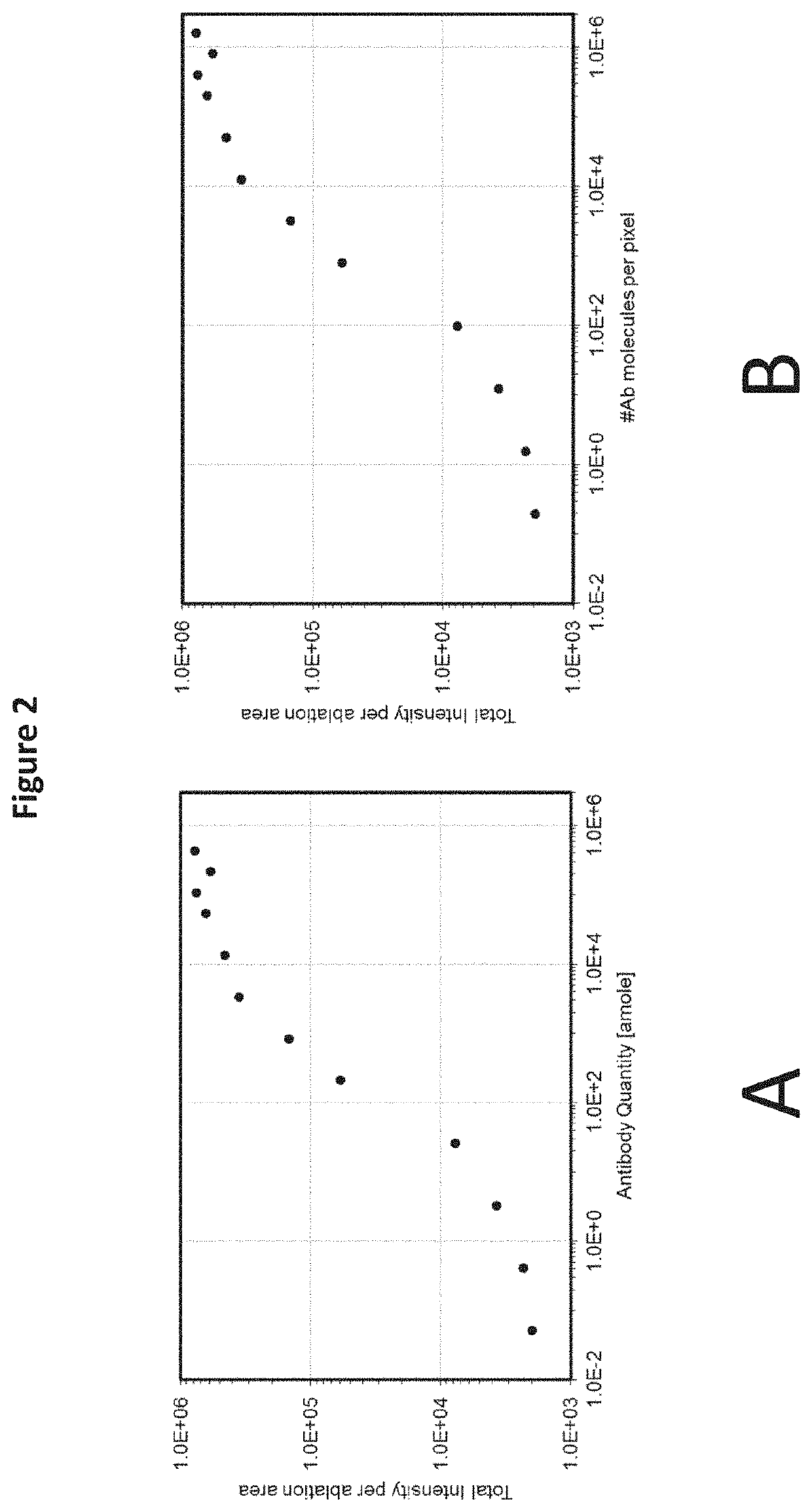Reagents and methods for elemental mass spectrometry of biological samples
a technology of elemental mass spectrometry and biological samples, applied in the direction of instruments, assay labels, peptides, etc., can solve the problem that the analysis has been limited to cellular samples
- Summary
- Abstract
- Description
- Claims
- Application Information
AI Technical Summary
Benefits of technology
Problems solved by technology
Method used
Image
Examples
example 1
Immobilisation of Detected Protein
[0665]To demonstrate quantification of protein species, antibodies labelled with mass tags were spotted onto a slide. The spots were ablated, and the number of ions counted and correlated with the concentrations and quantities of antibody present, thereby generating a calibration curve and providing an initial demonstration of a linear relationship between antibody concentration and ion count. Furthermore, multiplexed quantification was demonstrated.
[0666]Carboxyl functionalized glass slides (XanTec, Germany) were used for immobilisation of the antibodies. First, the slides were activated to form NHS functional groups, which are capable of covalently linking proteins with free amines to the slides. The antibodies immobilised to the plate were: (1) anti-CD20, labelled with 147Sm, (2) anti-CD138, labelled with 150Nd, (3) anti-CD183, labelled with 156Gd, (4) anti-CD357, labelled with 159Tb, (5) anti-CD45Ro, labelled with 165Ho, (6) anti-CD66a, labelled...
example 2
ent Immobilisation of Detected Protein
[0671]Example 1's experimental format relied on direct immobilisation of the detected protein to the slide (via reaction with NHS functionalities on the slide with amine on the detected protein species). In many instance, it is experimentally unviable to immobilise all species in a biological sample to the slide (e.g. tissue fluid which contains many proteinaceous and other chemical components). According, Example 2 demonstrates that specific proteins can be immobilised non-covalently to the mass cytometry sample carrier by a first immobilising a specific capture element to the slide before subsequent immobilisation of the target analyte. Beyond verification of this technique, the example demonstrates that the ion count is dependent of the amount of the specifically bound labelled target species immobilised on the slide, which in turn varies with the number of capture elements capable of binding specifically to the target that have been immobili...
example 3
of Mass Tagged Nucleotides
[0688]The inventors also demonstrate the capacity of IMC to quantitatively determine the concentration of nucleic acid.
[0689]A DNA oligonucleotide labelled with a Tb159-based mass tag was diluted to concentrations of 6.46 μM, 6.46×102 μM and 6.46×10−4 μM. 1 μl of the solution was manually or machine spotted onto Nexterion Slide E (Schott AG, Germany). Slides were then incubated in a humidity chamber for approximately 30 minutes before leaving to dry overnight. Dried samples were then baked on a heat block set to 80° C. for 4 hrs, before the following wash regime was carried out: washing in 1% Triton PBS for 5 minutes, washing twice in 1 mM HCl for two minutes and washing in 100 mM KCl for 10 minutes. Samples were then rinsed with H2O for approximately one minute prior to drying in preparation for imaging mass cytometry.
[0690]The total ion count determined from different sample concentrations are shown in FIG. 4A. The total ablation area was 500×500 μm2, wit...
PUM
| Property | Measurement | Unit |
|---|---|---|
| Fraction | aaaaa | aaaaa |
| Fraction | aaaaa | aaaaa |
| Fraction | aaaaa | aaaaa |
Abstract
Description
Claims
Application Information
 Login to View More
Login to View More - R&D
- Intellectual Property
- Life Sciences
- Materials
- Tech Scout
- Unparalleled Data Quality
- Higher Quality Content
- 60% Fewer Hallucinations
Browse by: Latest US Patents, China's latest patents, Technical Efficacy Thesaurus, Application Domain, Technology Topic, Popular Technical Reports.
© 2025 PatSnap. All rights reserved.Legal|Privacy policy|Modern Slavery Act Transparency Statement|Sitemap|About US| Contact US: help@patsnap.com



